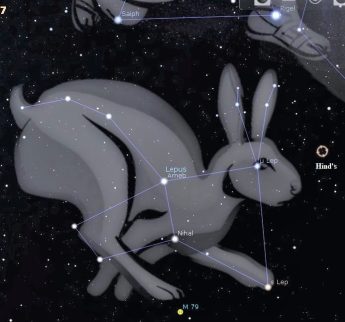This Week’s Sky at a Glance, 2025 Jan 18 – Jan 25
This Week’s Sky at a Glance, 2025 Jan 18 – Jan 25
There are many critters represented as constellations; birds, fish, canines, felines, insects, snakes and even a unicorn. But no rodents have been so honoured, although the second brightest star in Gemini is called Castor, which is the genus of beavers. However, some time ago the cute bunnies decided they didn’t want to be associated with rodents and called themselves lagomorphs. So, at the risk of being attacked by the killer rabbit of Arthurian filmdom, I will let them represent rodentia this week.
By 9:30 pm Orion stands high in the southern sky while Lepus the Hare cowers below his feet, hoping to avoid detection by Orion’s larger canine companion to the east. I see the constellation as three vertical pairs of stars, with the brightest pair in the middle and the widest to the right. With a reasonably dark sky you can see the bunny ears between the widest pair and Orion’s brightest star, Rigel. If you extend the middle pair down an equal distance a small telescope will reveal a fuzzy patch called M79. This globular cluster is unusual in that it is in our winter sky, whereas most of the globulars are seen among the summer constellations. M79 could be part of another galaxy that is interacting with the Milky Way.
If you draw a line from the top of the middle pair to the top of the widest pair and extend it a little more than half that distance, a telescope might pick up Hind’s Crimson Star, one of the reddest stars in the sky. Its brightness varies by a factor of 300 over 14 months, with the red colour being most pronounced at its dimmest.
This Week in the Solar System
Saturday’s sunrise is at 7:57 and sunset will occur at 5:12, giving 9 hours, 15 minutes of daylight. Next Saturday the Sun will rise at 7:51 and set at 5:21, giving 9 hours, 30 minutes of daylight.
The Moon is at third quarter phase and near Spica on Tuesday. Venus is a binocular view to the upper right of Saturn this weekend, and by next weekend it will be about 6 degrees above Saturn. Telescope users might see Jupiter’s moon Europa disappear behind the planet at 8:19 on Wednesday evening, and Io doing the same on Friday at 8:42. The Red Spot will be within view on both occasions. Mars makes a scenic line with Pollux and Castor this weekend, and over the week it will move up to the side of Pollux. Take note of the colour differences of Mars and the two stars. Mercury is moving sunward rapidly and is pretty much beyond observing until mid-February.
Tune in to the Sunday Night Astronomy Show at 8 pm on the YouTube channel and Facebook page of Astronomy by the Bay.

